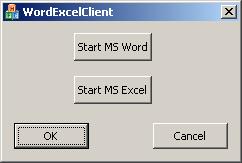Visual C++ - COM Client for Word and Excel - CoCreateInstance, IDispatch - ProgID Word.Application and Excel.Application
I have come up a COM Client Application that can create an instance for Word and Excel Application. I have used CoCreateInstance and I have not used any ATL classes in this sample code. I have used IDispatch interface the invoke the property "Visible". This can be done in two steps IDispatch->GetIDsOfNames(...) and IDispatch->Invoke(...) .
Source Code
// WordExcelClientDlg.cpp : implementation file
//
#include "stdafx.h"
#include "WordExcelClient.h"
#include "WordExcelClientDlg.h"
#ifdef _DEBUG
#define new DEBUG_NEW
#endif
// CAboutDlg dialog used for App About
class CAboutDlg : public CDialog
{
public:
CAboutDlg();
// Dialog Data
enum { IDD = IDD_ABOUTBOX };
protected:
virtual void DoDataExchange(CDataExchange* pDX); // DDX/DDV support
// Implementation
protected:
DECLARE_MESSAGE_MAP()
};
CAboutDlg::CAboutDlg() : CDialog(CAboutDlg::IDD)
{
}
void CAboutDlg::DoDataExchange(CDataExchange* pDX)
{
CDialog::DoDataExchange(pDX);
}
BEGIN_MESSAGE_MAP(CAboutDlg, CDialog)
END_MESSAGE_MAP()
// CWordExcelClientDlg dialog
IDispatch *exceldispatch = NULL;
CWordExcelClientDlg::CWordExcelClientDlg(CWnd* pParent /*=NULL*/)
: CDialog(CWordExcelClientDlg::IDD, pParent)
{
m_hIcon = AfxGetApp()->LoadIcon(IDR_MAINFRAME);
}
void CWordExcelClientDlg::DoDataExchange(CDataExchange* pDX)
{
CDialog::DoDataExchange(pDX);
}
BEGIN_MESSAGE_MAP(CWordExcelClientDlg, CDialog)
ON_WM_SYSCOMMAND()
ON_WM_PAINT()
ON_WM_QUERYDRAGICON()
//}}AFX_MSG_MAP
ON_BN_CLICKED(IDC_BUTTON1, &CWordExcelClientDlg::OnBnClickedButton1)
ON_BN_CLICKED(IDC_BUTTON2, &CWordExcelClientDlg::OnBnClickedButton2)
ON_BN_CLICKED(IDOK, &CWordExcelClientDlg::OnBnClickedOk)
ON_BN_CLICKED(IDCANCEL, &CWordExcelClientDlg::OnBnClickedCancel)
END_MESSAGE_MAP()
// CWordExcelClientDlg message handlers
BOOL CWordExcelClientDlg::OnInitDialog()
{
CDialog::OnInitDialog();
// Add "About..." menu item to system menu.
// IDM_ABOUTBOX must be in the system command range.
ASSERT((IDM_ABOUTBOX & 0xFFF0) == IDM_ABOUTBOX);
ASSERT(IDM_ABOUTBOX < 0xF000);
CMenu* pSysMenu = GetSystemMenu(FALSE);
if (pSysMenu != NULL)
{
CString strAboutMenu;
strAboutMenu.LoadString(IDS_ABOUTBOX);
if (!strAboutMenu.IsEmpty())
{
pSysMenu->AppendMenu(MF_SEPARATOR);
pSysMenu->AppendMenu(MF_STRING, IDM_ABOUTBOX, strAboutMenu);
}
}
// Set the icon for this dialog. The framework does this automatically
// when the application's main window is not a dialog
SetIcon(m_hIcon, TRUE); // Set big icon
SetIcon(m_hIcon, FALSE); // Set small icon
// TODO: Add extra initialization here
return TRUE; // return TRUE unless you set the focus to a control
}
void CWordExcelClientDlg::OnSysCommand(UINT nID, LPARAM lParam)
{
if ((nID & 0xFFF0) == IDM_ABOUTBOX)
{
CAboutDlg dlgAbout;
dlgAbout.DoModal();
}
else
{
CDialog::OnSysCommand(nID, lParam);
}
}
// If you add a minimize button to your dialog, you will need the code below
// to draw the icon. For MFC applications using the document/view model,
// this is automatically done for you by the framework.
void CWordExcelClientDlg::OnPaint()
{
if (IsIconic())
{
CPaintDC dc(this); // device context for painting
SendMessage(WM_ICONERASEBKGND, reinterpret_cast<WPARAM>(dc.GetSafeHdc()), 0);
// Center icon in client rectangle
int cxIcon = GetSystemMetrics(SM_CXICON);
int cyIcon = GetSystemMetrics(SM_CYICON);
CRect rect;
GetClientRect(&rect);
int x = (rect.Width() - cxIcon + 1) / 2;
int y = (rect.Height() - cyIcon + 1) / 2;
// Draw the icon
dc.DrawIcon(x, y, m_hIcon);
}
else
{
CDialog::OnPaint();
}
}
// The system calls this function to obtain the cursor to display while the user drags
// the minimized window.
HCURSOR CWordExcelClientDlg::OnQueryDragIcon()
{
return static_cast<HCURSOR>(m_hIcon);
}
void CWordExcelClientDlg::OnBnClickedButton1()
{
::CoInitialize(NULL);
IDispatch *worddispatch = NULL;
if( worddispatch == NULL)
{
CLSID clsid;
CLSIDFromProgID(L"Word.Application", &clsid);
HRESULT hRes = CoCreateInstance(clsid, NULL, CLSCTX_LOCAL_SERVER,
IID_IDispatch, (void**)&worddispatch);
if(FAILED(hRes))
{
MessageBox("Failed to create MS Word Application Object");
return;
}
DISPID dispidVisible;
OLECHAR *propertyName = L"Visible";
hRes = worddispatch->GetIDsOfNames(IID_NULL, &propertyName, 1, LOCALE_SYSTEM_DEFAULT, &dispidVisible);
if(FAILED(hRes))
{
MessageBox("Failed to access MS Word Application Methods");
return;
}
unsigned returnArg;
VARIANT varTrue;
DISPID rgDispidNamedArgs[1];
rgDispidNamedArgs[0] = DISPID_PROPERTYPUT;
DISPPARAMS params = { &varTrue, rgDispidNamedArgs, 1, 1 };
varTrue.vt = VT_BOOL;
varTrue.boolVal = 0xFFFF;
hRes = worddispatch->Invoke(dispidVisible, IID_NULL, LOCALE_SYSTEM_DEFAULT, DISPATCH_PROPERTYPUT, ¶ms, 0, 0, &returnArg);
if(FAILED(hRes))
{
MessageBox("Failed to access MS Word Application Methods");
return;
}
worddispatch->Release();
}
}
void CWordExcelClientDlg::OnBnClickedButton2()
{
::CoInitialize(NULL);
if( exceldispatch == NULL)
{
CLSID clsid;
CLSIDFromProgID(L"Excel.Application", &clsid);
HRESULT hRes = CoCreateInstance(clsid, NULL, CLSCTX_LOCAL_SERVER,
IID_IDispatch, (void**)&exceldispatch);
if(FAILED(hRes))
{
MessageBox("Failed to create Excel Application Object");
return;
}
DISPID dispidVisible;
OLECHAR *propertyName = L"Visible";
hRes = exceldispatch->GetIDsOfNames(IID_NULL, &propertyName, 1, LOCALE_SYSTEM_DEFAULT, &dispidVisible);
if(FAILED(hRes))
{
MessageBox("Failed to access Excel Application Methods");
return;
}
unsigned returnArg;
VARIANT varTrue;
DISPID rgDispidNamedArgs[1];
rgDispidNamedArgs[0] = DISPID_PROPERTYPUT;
DISPPARAMS params = { &varTrue, rgDispidNamedArgs, 1, 1 };
varTrue.vt = VT_BOOL;
varTrue.boolVal = 0xFFFF;
hRes = exceldispatch->Invoke(dispidVisible, IID_NULL, LOCALE_SYSTEM_DEFAULT, DISPATCH_PROPERTYPUT, ¶ms, 0, 0, &returnArg);
if(FAILED(hRes))
{
MessageBox("Failed to access Excel Application Methods");
return;
}
// do not release now otherwise it will close the excel application
//exceldispatch->Release();
}
}
void CWordExcelClientDlg::OnBnClickedOk()
{
if(exceldispatch != NULL)
exceldispatch->Release();
OnOK();
}
void CWordExcelClientDlg::OnBnClickedCancel()
{
if(exceldispatch != NULL)
exceldispatch->Release();
OnCancel();
}
Click here to download the VS 2005 Project file and executable
Output

|
|